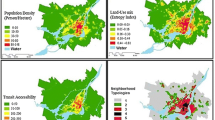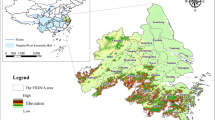Abstract
To understand the household CO2 emission level in China, as well as how much the neighborhoods’ socio-economic or design factors could influence the CO2 emission, 23 neighborhoods in Jinan were investigated in 2009 and 2010. These neighborhoods fall into four different types: superblock, enclave, grid and traditional. The household CO2 emission includes sources of both inhome energy use and passenger transportation. The average CO2 emission per household is 7.66 t·a-1, including 6.87 t in-home operational emission and 792 kg transportation emission. The household CO2 emission by neighborhood categories is 10.97, 5.65, 6.49, 5.40 t·household−1·a−1 for superblock, enclave, grid and traditional respectively. Superblock has the highest average emission and also the highest percent (more than 25%) of transportation emission among four different types of neighborhoods. The residential CO2 emission of superblock neighborhoods in Jinan has already reached the level in developed countries nearly ten years ago. It is predictable that more superblock neighborhoods would be built in China with the fast urbanization. How to avoid the rapid household CO2 emission growth in the future would be a systematic issue. The study also found that in addition to income and apartment area, household density, land use mix and accessibility to public transportation are three primary factors which have significant impacts on CO2 emission. High density, mixed land use and convenient accessibility to public transportation tend to reduce household CO2 emission.
Similar content being viewed by others
References
UNDESA. World Population Prospects: the 2008 Revision. United Nations: United Nations Publication, 2008
Wheeler S. Urban planning and global climate change. In: LeGates R T, Stout F, eds. City Reader, 5th ed. New York: Taylor & Francis, 2011, 458–467
Huo Y, Zheng S Q, Yang Z. Low-carbon lifestyle and its determinants: an empirical analysis based on survey of “household energy consumption and community environment in Beijing”. Journal of Urban and Regional Planning, 2010, (2): 55–72 (in Chinese)
National Bureau of Statistics. China Statistical Yearbook 2011. Beijing: China Statistics Press, 2012 (in Chinese)
Dhakal S. Urban energy use and carbon emissions from cities in China and policy implications. Energy Policy, 2009, 37(11): 4208–4219
He D Q, Jiang Y, Wang Y, Calthorpe P. People-oriented urban planning and construction is the core of low-carbon development. In: Chinese Society for Urban Studies, ed. China Low-Carbon Eco-City Development Report, 2nd ed. Beijing: China Building Industry Press, 2011, 286–299 (in Chinese)
Ewing R, Meakins G, Bjarnson G, Hilton H. Transportation and land use. In: Dannenberg A L, Frumkin H, Jackson R J, editors. Making Healthy Places. Washington, D C: Island Press/Center for Resource Economics, 2011, 149–169
Kahn M E. The environmental impact of suburbanization. Journal of Policy Analysis and Management, 2000, 19(4): 569–586
Kitamura R, Mokhtarian P L, Daidet L. A micro-analysis of land use and travel in five neighborhoods in the San Francisco Bay Area. Transportation, 1997, 24(2): 125–158
Jiang Y, He D Q, Zegras C. Impact of neighborhood land use on residents travel energy consumption. Urban Transport of China, 2011, (4): 21–29 (in Chinese)
Li S H, Kang H. Practical Central Heating Handbook. Beijing: China Electric Power Press, 2005 (in Chinese)
National Bureau of Statistics. China Statistical Yearbook 2008. Beijing: China Statistics Press, 2009 (in Chinese)
Zheng Y P, Chen Q S. Simulation calculation of bus fuel economy under city traffic environment. Tractor & Farm Transporter, 2008, (04): 44–45
Cherry C R, Weinert J X, Yang X M. Comparative environmental impacts of electric bikes in China. Transportation Research Part D, Transport and Environment, 2009, 14(5): 281–290
Rajamani J, Bhat C, Handy S, Knaap G, Song Y. Assessing impact of urban form measures on nonwork trip mode choice after controlling for demographic and level-of-service effects. Transportation Research Record, 2003, 1831(1): 158–165
Mu R, Jong M. Establishing the conditions for effective transitoriented development in China: the case of Dalian. Journal of Transport Geography, 2012, 24(0): 234–249
Qin B, Han S S. Planning parameters and household CO2 emission: evidence from high- and low-carbon neighborhoods in Beijing. Habitat International, 2012, 37(0): 52–60
Kerkhof A, Benders R M, Moll H. Determinants of variation in household CO2 emissions between and within countries. Energy Policy, 2009, 37(4): 1509–1517
Lenzen M, Wier M, Cohen C, Hayami H, Pachauri S, Schaeffer R. A comparative multivariate analysis of household energy requirements in Australia, Brazil, Denmark, India and Japan. Energy, 2006, 31(2–3): 181–207
Fahmy D E, Thumim J, White V. The Distribution of UK Household CO2 Emissions: Interim Report. York, UK: Joseph Rowntree Foundation, 2011
Ewing R, Cervero R. Travel and the built environment. Journal of the American Planning Association, 2010, 76(3): 265–294
Liu C, Shen Q. An empirical analysis of the influence of urban form on household travel and energy consumption. Computers, Environment and Urban Systems, 2011, 35(5): 347–357
Newman P, Kenworthy J R. Sustainability and Cities: Overcoming Automobile Dependence. Washington: Island Press, 1999
Ewing R, Rong F. The impact of urban form on U.S. residential energy use. Housing Policy Debate, 2008, 19(1): 1–30
Walters J, Ewing R. Measuring the benefits of compact development and vehicle miles and climate change. Environmental Practice, 2009, 11(03): 196–208
Holden E, Norland I T. Three challenges for the compact city as a sustainable urban form: Household consumption of energy and transport in eight residential areas in the greater Oslo region. Urban Studies (Edinburgh, Scotland), 2005, 42(12): 2145–2166
Mashayekh Y, Jaramillo P, Samaras C, Hendrickson C T, Blackhurst M, MacLean H L, Matthews H S. Potentials for sustainable transportation in cities to alleviate climate change impacts. Environmental Science & Technology, 2012, 46(5): 2529–2537
Xu K M, Xie J H, Feng J. The advantages and benefits analysis for bus rapid transit stations. Urban Transport of China, 2006(6): 29–33 (in Chinese)
Author information
Authors and Affiliations
Corresponding authors
Rights and permissions
About this article
Cite this article
Guo, J., Liu, H., Jiang, Y. et al. Neighborhood form and CO2 emission: evidence from 23 neighborhoods in Jinan, China. Front. Environ. Sci. Eng. 8, 79–88 (2014). https://doi.org/10.1007/s11783-013-0516-1
Received:
Accepted:
Published:
Issue Date:
DOI: https://doi.org/10.1007/s11783-013-0516-1




